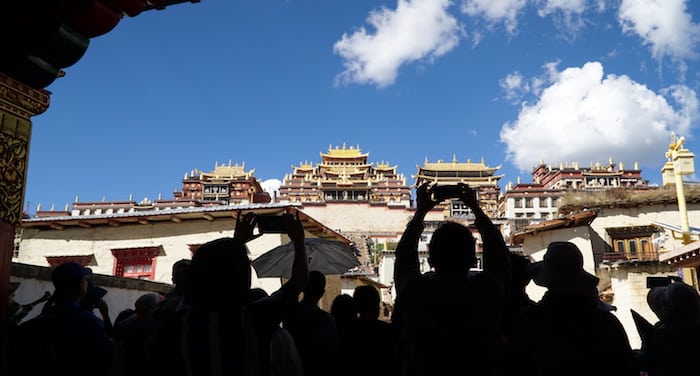 Ganden Sumtsenling Monastery or Songzanlin Temple – Photo by Matteo Bosi
Ganden Sumtsenling Monastery or Songzanlin Temple – Photo by Matteo Bosi
Perched on the slopes of the Himalayas at an altitude of over 3.000 mt, at the most northern point of the multi-ethnic region of Yunnan, as well as the crossroads of people with an extraordinary folklore and the entrance gate to Tibet: this is the city of Zhongdian, better known as Shangri-la. It is the chief city of the (majority) Tibetan prefecture of Diqing.
The history of this name is not the history of the place. Or better yet, it became so. This is where it would be really appropriate to start with “Once upon a time”, yes: once upon a time there was the writer James Hilton and his novel Lost Horizon ; and then there was the director, the famous Frank Capra and his masterpiece of the same name.
The story tells about a perfect city, wrapped up in and well protected by the Himalayas, with a civilization that secretly lived in harmony hidden away from the greed and selfishness of the modern world. Only the story’s protagonist came to fully understand the community’s mission.
The mysterious fascination of this place that for a long time has lead several to track down the remote places in China, has today been widely recognized as Zhongdian of Yunnan (although others try to make the same claim).
So strong is the desire to not have this identity taken away, that even the name Zhongdian (中甸) is by now almost obsolete, having been replaced by the “high-sounding” Xianggelila (香格里拉) which is nothing more than a transliteration of Shangri-la. When it comes to the characters of this paradise, you can thank the Tibetan culture for the city’s having still preserved something mystical and seductive.
Although Hilton’s book goes back to the Thirties, the city has taken on this name only since the beginning of the 2000’s, after several neighbors tried to carve out a portion of the ardent tourism that has come to Lijiang in recent years. For its (mis)fortune and a good portion of tourists, Shangri-la is no longer under assault in that regard. The reasons for visiting this corner of Yunnan, therefore, are much more than seeking paradise lost.
Here all the ethnic groups of the area meet and mix, with a majority of Tibetans; this is the place to go if you’re dreaming of Tibet but can’t make it that far. This is a stop to include if you’re looking for the natural side of Yunnan, the destination for avid photographers who prefer wide fields and saturated colors.
In my opinion, this is one of the most brilliant and attractive corners of Yunnan, as well as an unforgettable travel experience.
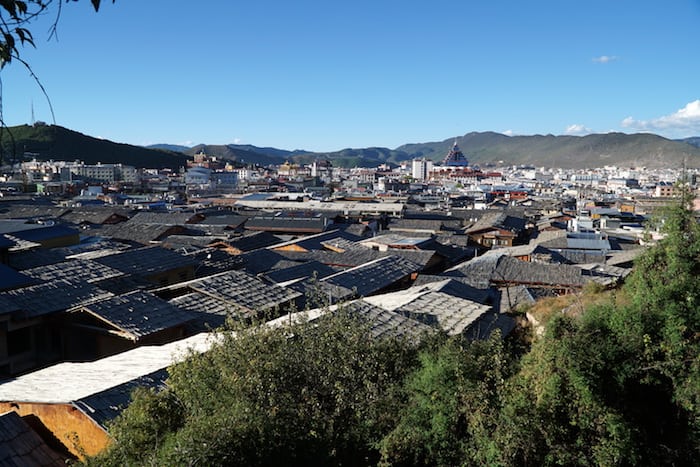 The roofs of Shangri-la seen from above at Guishan Hill – Photo by Matteo Bosi
The roofs of Shangri-la seen from above at Guishan Hill – Photo by Matteo Bosi
When to go to Shangri-la
Since the city of Shangri-la is located in the Himalayas, the altitude plays a fundamental role in its weather. And that’s a big factor to keep in mind when planning a trip that includes this extraordinary destination; but I’ll speak more of this below.
This is not an area that registers excessively cold temperatures, because it’s well protected between the mountains, but in general I strongly recommend against visiting between November and February: tourist amenities aren’t easy and this is not a well organized mountain destination. In fact, keep in mind that normally, even with clear skies and the tourist season in full swing, it’s hard to reach these inaccessible areas; it’s even harder during the cold months with lots of snow possible.
March – October is the right window for visiting Shangri-la, with the exception of the usual times with major influxes of tourists on the Chinese calendar (Qing Ming holidays, Dragon Boat and the National Holiday in October). August is a rainy month and in October it already gets rather cold in the evenings.
The difference in temperature between night and day is noteworthy and hotels don’t always offer central heating and radiators. The room we stayed in during our visit opened directly into the external courtyard, so entering and exiting we had to literally launch ourselves without hesitation from one to the other, and with the door opening every twenty seconds made the asthmatic blowing of the only air conditioner we had in vain.
Another detail is that the sun burns ferociously: you’re literally forced to go from short sleeves to down jackets if a passing cloud blocks the sun. But when it comes back out, without SPF 50 sunblock you’re like sausage on a plate. The sunlight, shining and clear, is blinding. And the colors are so vivid they are stunning. You won’t be able to get enough!
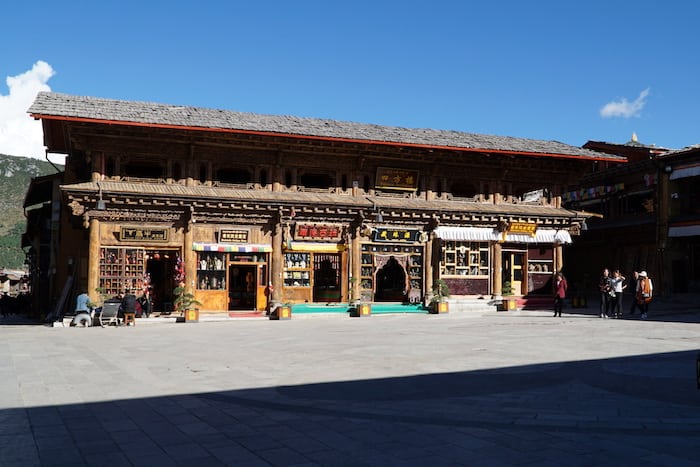 Sifang Jie – Photo by Matteo Bosi
Sifang Jie – Photo by Matteo Bosi
How to get there and get around
Sadly, at the time of writing, getting to Shangri-la is still rather hard compared to other destinations. You’re forced to fly taking a short domestic flight, or go by land from Lijiang. Here is where the closest train station is located.
The Shangri-la airport is called Diqing (Diqing Shangri-la Airport) and its a small stop served only domestically from: Kunming, Beijing, Shanghai, Chongqing, Chengdu, Xi’An, Guangzhou, Xishuangbanna and Lhasa.
Therefore there’s no way to reach the city directly from Europe, but you’ll have to consider a stop in one of the major cities listed above. The alternative to flying is ground transport. This option is to be considered especially if you’re sensitive to altitude, since the trip up to Lijiang usually helps one physically and gradually acclimate to the 3.160 meters above sea level of Shangri-la.
The airport is very close to the historic center and there’s no shuttle bus service. A taxi costs 30 Yuan for the trip.
The car or bus connection from Lijiang takes about 3-4 hours of driving, depending on weather conditions. Fortunately the new highway makes the ride easier. But don’t think that this is one of those really spacious four-lane highways you saw in Shanghai. This is more like a comfortable provincial road winding through the mountains, with isolated alpine huts and yaks grazing alongside the road (when they’re not actively crossing it).
For bus connections:
- from Lijiang, from the bus station, a bus leaves nearly every 40 minutes in the morning, every hour through the afternoon until 5, for a little less than 60 Yuan. About 5 hours of travel on good roads with bucolic mountain landscapes.
- from Dali, or better yet, the Xiaguan North Bus Station, there are day and night buses that cover the six hours of travel; departures from 6.20 to 11.00 in the morning every half hour, and then at 20.00, for less than 100 Yuan a ticket. Wisely, you can opt for the train to Lijiang and then get on a bus.
- to and from Kumning, very strongly not recommended, there’s a flight!
- to Deqin (which is the northernmost county, on the border with Tibet), now that the road has been fixed you can get there in about 5 hours, but it is a trip through high mountains; 4 buses a day starting in the morning (7:20, 8:20, 9:20, 12:00).
- to Lhasa: Tibet’s capital is really far away, to be clear; don’t be fooled by the fact that this area of Yunnan was part of the Kham region. Lhasa can be reached by air in less than two hours. The trip by road uses the new highways; it’s an option to be considered for those who want a road trip through wild, raw Asia where in some areas people are still living minimally. It’s 1600 km of a unique experience. Nevertheless, remember that entrance visas for Tibet are subject to continuing variations of availability, which unfortunately follow the mood of Chinese politics. Check our guide so as not to go wrong!
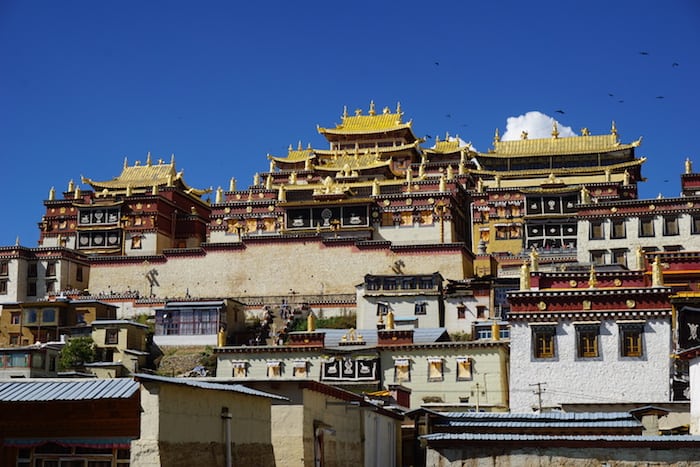 The Songzanlin Monastery – Photo by Fabio Andreetti
The Songzanlin Monastery – Photo by Fabio Andreetti
Getting around inside the city is very easy: the historic center can be toured entirely in foot, even if you get a little lost in its alleyways, but by lifting your head you can always orient yourself thanks to the presence of imposing Guishan Hill that watches over the city.
But to reach the points of interest outside of the historic center, take a look at this list:
- Potatso National Park or Pudacuo National Park (普达措国家公园): it’s not recommended that you take the bus, which among other things has limited service (four morning runs between 8 and 10, and four return runs between 14 and 16.30); a taxi or organized car would be better.
- Ganden Sumtseling Monastery or Songzanlin Si (松赞林寺): with Line 3 you can get close to the area’s entrance plaza; from there, after getting a ticket, take a tourist boat that crosses the land and brings you as far as the actual temple entrance.
- Haba Snow Mountain (哈巴雪山): here too it’s best to hire a car and driver.
- Meili Snow Mountain (梅里雪山): get to Deqin and then rent a car and driver.
- Tiger Leaping Gorge (虎跳峡): it’s located almost halfway between Lijiang and Shangri-la, so it’s a frequent intermediate stop on the trip up to Zhongdian. If instead you’d like to get there from Shangri-la, you can then hop on one of the buses going to Lijiang which stop at the village of the Gorge, where you can look for the boats that bring you to the entrance to the park. In this case too the best option for flexibility is hiring a driver.
Where to stay in Shangri-la
There are many hotels in Shangri-la and they’re generally well arranged within typical Tibetan buildings – it’s just up to you to decide where to stay inside the historic center.
Be careful though: in 2014 a terrible fire broke out here that destroyed more than 200 buildings, which were quickly rebuilt, even if the work was still going on in some parts when I visited. Reconstruction work was designed to respect the original shape of the buildings, but the shiny, new, well-smoothed wood doesn’t lie and can’t camouflage the years of history that they haven’t lived. There’s a part in the center that didn’t get damaged, and it’s best to stay there.
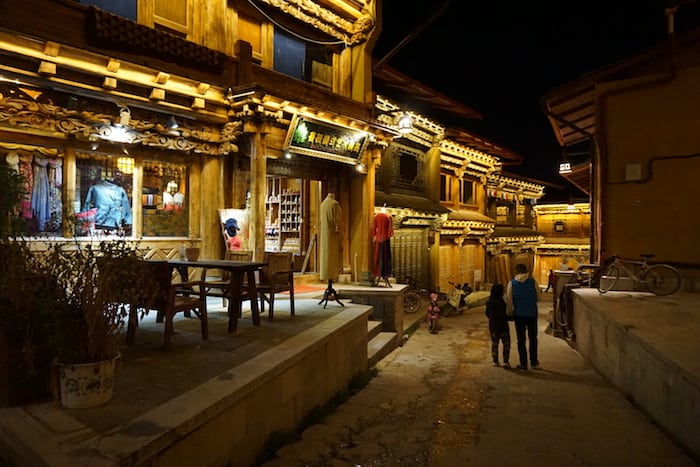 The streets in the historic center of Shangri-la in the evening – Photo by Fabio Andreetti
The streets in the historic center of Shangri-la in the evening – Photo by Fabio Andreetti
I was at the E-Outfitting Boutique Hotel whose rooms are wonderful decorated in Tibetan style. In particular the room we had directly faced the entrance courtyard, over which opened an enormous window. Wonderful.
It’s a shame that no matter how darkened the glass might be, we didn’t make good use of this mirror to the outside for obvious reasons of privacy that if you’ve toured China a bit you’ll know that it is a different concept (and if you don’t, take a look at what happened to me in Hangzhou!).
However there’s a wealth of choices. Opt for Tibetan style furnishings and better yet for homestay options rather than hotel chains. They’ll help you drop into the colorful lives of these families and the slow rhythms tied to the climate, altitude and prayer.
Click here to find the best places to spend the night in Shangri-la.
What to see in Shangri-la
First of all, Shangri-la. Or better, the historic village of Dukezong (独克宗古城), which is essentially the historic center. You visit it on foot: at sunrise, in the middle of the morning under a burning sun, in the evening when the lights go on, at night when everyone else is sleeping. Any time of the day gifts you a moving glimpse, yet not just from a “photographic” point of view. As a base of Tibetan culture, the experience is always something mystic and spiritual. Unfortunately commercialization has given a negative slap to the peaceful routine of what once was a small town.
Now, getting on the main road of the new Shangri-la, there’s the impression of getting on to a large stage where everything must necessarily be gaudy and colorful. Massive cement buildings clash against little houses of sculpted wood in the center, and everything that now surrounds the historic center is nothing more than the expensive result of the modern tourism boom.
It’s better in some ways, with new generations no longer forced to stand next to a yak due to a lack of choices. But the loss of traditions and cultural flattening go on without a break; in Yunnan, a more attentive tourist never stops warning about this alienation everywhere they go.
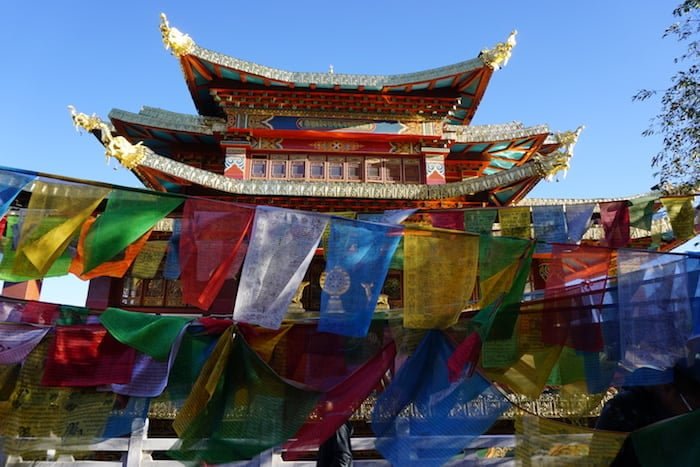 The Da Gui Shang Temple – Photo by Fabio Andreetti
The Da Gui Shang Temple – Photo by Fabio Andreetti
Fortunately the mountains protect this wonder. Rather, by a pleasant walk (Note: we’re at 3000 meters, if you think that you can take these two stairs lightly, you’re quite wrong…!), you get to the hill where there’s the Da Gui Shang Temple. Here’s one of the city’s great sources of pride: a gigantic hand-turned prayer mill, but the hands of at least ten people! Three turns are recommended.
From here you can also admire both the roofs of the old city as well as more recent buildings, climbing up the profile of the mountains, ruining its purity; and above all else you can admire from afar what was one of the most extraordinary spectacles I saw in Yunnan: Songzanlin Temple.
The Ganden Sumtseling Monastery or Songzanlin Si (松赞林寺) for all its fame and beauty has earned the nickname of Little Potala Palace, referring to its big brother in Lhasa. It is an extensive complex that rises just outside of the city: the actual Monastery is made up of two structures (Zhacang and Jikang) which climb up the slopes of the mountain (200 steps!) and dominate the conglomeration underneath, packed with residences, some temporary, of the monks.
The Monastery is famous because it is tied to the affairs of the Dalai Lama; during the Cultural Revolution it suffered huge damage, but the local population and the faithful restored and rebuilt it over time. Take the time to visit all its places and turn its prayer wheel to get a blessing from a monk. These often recite their prayers and hand out typical bracelets of wood (though they’re most likely plastic)…in exchange for a banknote.
From my experience in China I noted that mass Buddhism often resorts to the monetizing of prayers, and the bigger and more famous a monastery is, the more banknotes there are – thrown in the water, tucked into the cracks of statues, in the grout of the tiles… To the point that as fascinating as a visit was, the obsessive presence of Mao’s portrait made me uneasy.
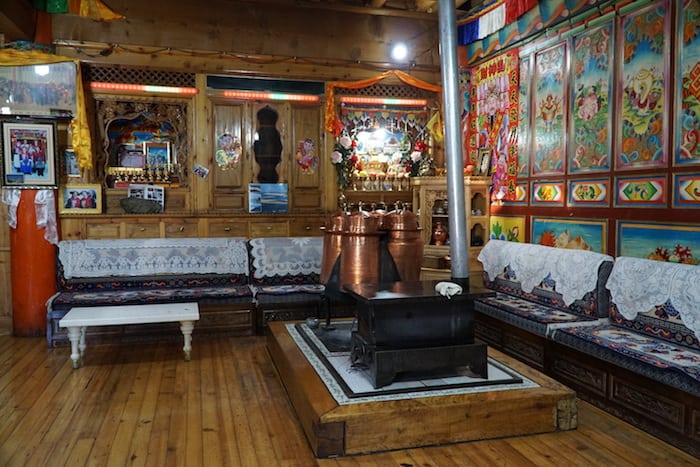 The interior of a Tibetan house with skins holding yak butter – Photo by Matteo Bosi
The interior of a Tibetan house with skins holding yak butter – Photo by Matteo Bosi
Around the cluster of the monastery and monks’ homes, is the Tibetan countryside: recent modern homes all flaunt massive windows, evidently built later on that cover the internal courtyard and protect it from the cold.
When it comes to architectural elegance they leave a little to be desired; but here they don’t care much about urban harmony, and care much more about controlling the temperature, managing spaces in the typical Tibetan way. So the lower floor is not a “livable” area, but more of a section reserved for work or even animals. The family lives on the first floor, with a large heated central space where they eat their meals and preserve…yak butter. And the TV.
You’ll find the monastery at its peak mystic appeal during times of prayer: up to 1600 monks can gather seated in prayer. Unfortunately during my visit, the more than 1600 monks were joined by 1600 thousands of tourists; but the brilliance of the colors and the imposing nature of the building will undeniably stay in your heart. For the rest you’ll have to bridge with fantasy…or choose the low season.
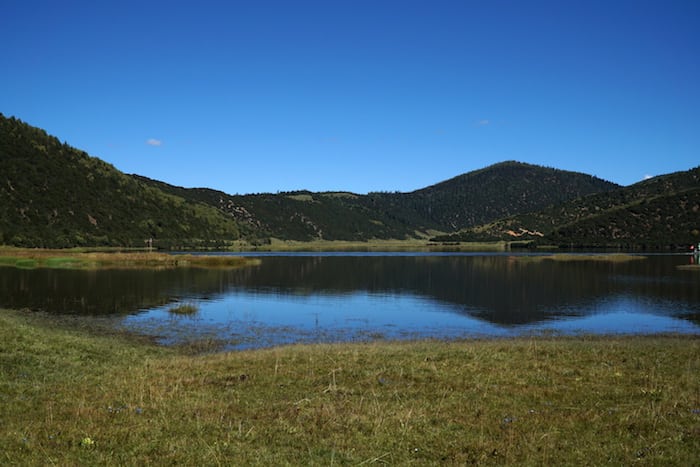 Pudacuo National Park – Photo by Matteo Bosi
Pudacuo National Park – Photo by Matteo Bosi
Pudacuo National Park (普达措国家公园) is one of the gems of Yunnan because it holds the distinction of being the first official national park designated by China in 2007. At the time of my visit, only one of the two lakes (Bitahai 碧塔海 and Shuduhu 属都湖) could be visited. The set trail surrounds the lake, which can also be crossed by boat (for a fee).
The area is immersed in a silence that is unusual for China, in a valley covered with lush vegetation and inhabited by horses that are more or less wild. Sadly this glimpse of nature isn’t entirely enjoyable because to hold back the large crowds that pour into it, you can only stay on the designated path or hop onto one of the transportation options available. So don’t think you’ll get to have a picnic on the shore, no matter how respectful of nature you might be.
Besides the stupendous natural landscape and the two lakes that I mentioned, inside Pudacuo Park there’s also the Tibetan village of Xiagei, which you can also visit.
Far outside the city of Shangri-la, and intended as a secondary destination, you’ll find the Baishui (白水台) terraces: these are terraced limestone formations, covered by iridescent water depending on the season. It’s located about 100km from Zhongdian, in Naxi territory. For some it’s a unique experience, for others an avoidable stop. The water’s color definitely depends on the weather; it’s generally sparsely visited. So long as you avoid the cold and rainy seasons, visiting in the middle seasons isn’t wasted time.
As far as experiences go, obviously the area is especially known for mountain trekking, and there’s a wide selection of choices. If you want a trip centered on discovering the mountains of Yunnan, don’t forget about the altitude and head further north toward Deqin, where the landscape is even more wild and barren.
From Shangri-la, trekking is usually recommended on the mountains Meili and Haba: the first being further north, the second on the road toward Lijiang.
As excellent as the panoramas are, I recommend that you involve a guide because Chinese alpine services are not as comprehensive as on our slopes. Generally, a mid to high level of ability is required, or at least a good pair of legs. Trekking packages vary in length, even more than one day.
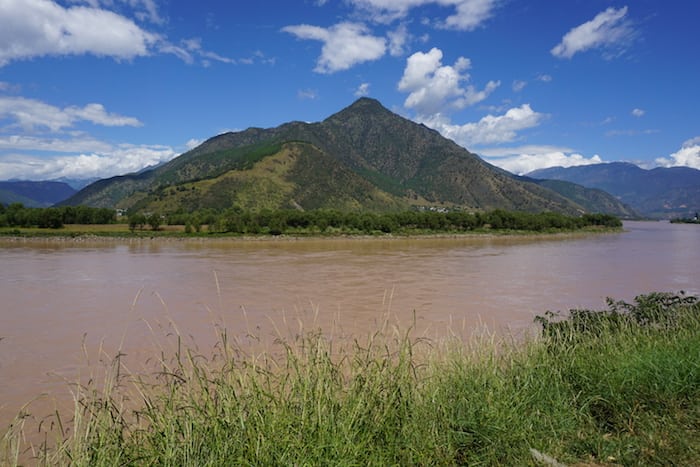 The First Bend of the Yangtze River – Photo by Fabio Andreetti
The First Bend of the Yangtze River – Photo by Fabio Andreetti
Another stop on the itinerary from Lijiang, but honestly of limited interest, is the famous first bend of the Yangtze. It’s so famous that it has its own name, The First Bend of Yangtze River (长江第一湾) in fact, to attract carovans of tourists going from south to north. They regularly stop at the edge for a photo of the panorama: a promontory circumvented by the river, and with this dribbling renown it continues eastward as far as Shanghai. Honestly this is a very avoidable pit stop, since it’s nothing more than a bend in the river whose fame was enlarged as a result of China’s patriotic pride regarding the third longest river in the world. Nevertheless the road between Lijiang to Shangri-la is long, so this stop has become an opportunity to refresh travelers.
In reality, the main stop on a typical tour stopping in both Lijiang and Shangri-la (even going to Dali first), is without a doubt Tiger Leaping Gorge. Here, if you have the time, you can’t miss out on several days of trekking: that way your legs can peacefully rest a few hours in the car while you admire the views offered on the long trip toward Zhongdian.
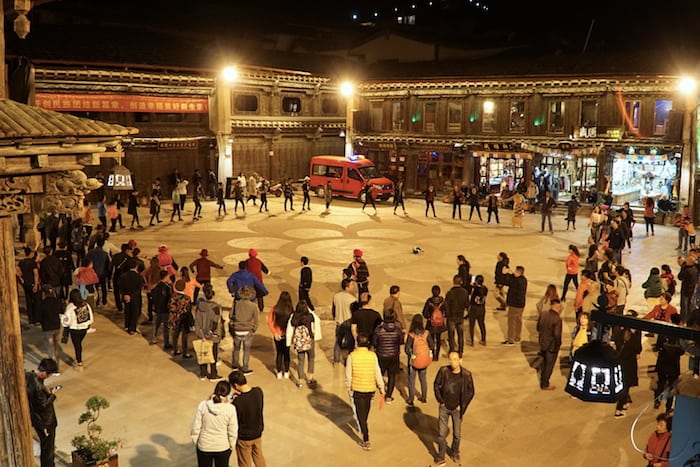 Tibetan group dances – Photo by Matteo Bosi
Tibetan group dances – Photo by Matteo Bosi
Along with places to visit, Shangri-la offers various activities that allow you to explore the area’s nature or come into contact with Tibetans that are the ethnic majority in this prefecture. Obviously trekking, from mountains to lakes, but even biking: especially around Lake Napa (Napahai 纳帕海) which appears after the rainy season.
To come into contact with Tibetan customs, quite often guides offer the chance to go into typical homes of familes where you’ll be offered yak butter tea, or where you can try their invigorating (and high calorie) breakfast, again seasoned with yak butter.
If that type of activity doesn’t interest you, in the main plaza of the historic center, Sifang Jie, dances break out in the evening, just as in the rest of China. This is preferable when the temperature allows you to move around… The dances of Tibetan groups go in a circle moving rhythmically around and back and forth. Participation by the curious is allowed, but preferably outside the circle!!
The Tibetans
Shangri-la is an option for those looking to learn about Tibetan culture but can’t get as far as Tibet. It’s not the only place in China where this ethnic group remains firmly established: Qinghai is among the most populous regions, as is Gansu and also Sichuan.
The traits you’ll most easily encounter in Shangri-la are obviously thearchitecture, in the massive example of Songzanlin Temple. In the historic center there are homes that have been redone and stuccoed, but in the part that was saved from the fire you can encounter the authentic.
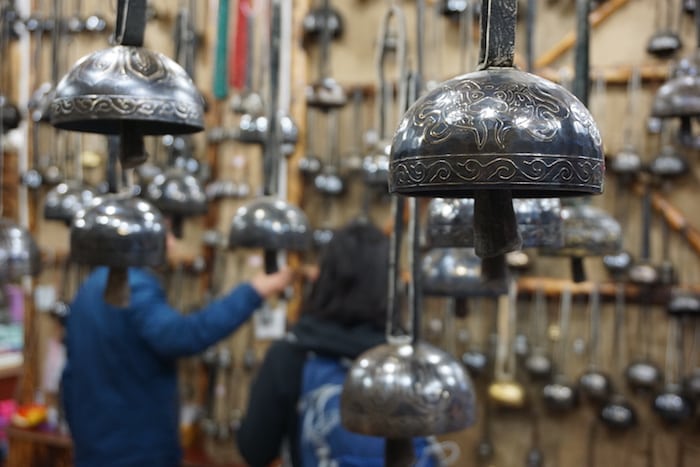 A store of Tibetan bells – Photo by Fabio Andreetti
A store of Tibetan bells – Photo by Fabio Andreetti
Several stores sell “typical” local products, such as yak products, which are everywhere in the area, or bells, and clothing. Tibetan colors are still frequently used, at least by women of a certain age. When it comes to shopping, I can’t guarantee the authenticity of the products, but they have a notable resemblance to the originals.
As I previously said, diving into the musical folklore is easy to do in the evening when dancing in the square gets started. There’s no lack of taverns if you’d like to eat Tibetan food, but the cuisine is now confused with the multi-ethnic cuisine of Yunnan. Taste the tsampa and the typical Tibetan breakfast, where they serve butter tea, or tea served with yak butter. Energy for cold months!
When speaking about Tibetan culture you can’t help but think about Tibetan Buddhism. In a place like Zhongdian, it’s the most widely practiced religion, with a reserved and respectful faith. Therefore even tourists are requested to consider the sacredness of the place and behave appropriately.
If you’re able to let yourself go at the sound of the prayers, be intoxicated by the dense smoke of yak butter burned in the temples, and give in to the hypnotic fascination of the colors, Songzanlin will be an experience for your body and soul.
The Tibetans are a hospitable and smiling people. They are fighting a battle to keep a little of their thousand year old culture alive, so for them it’s a pleasure when tourists are actively interested in their history and customs.
Bon voyage, and for any issues, leave a comment!



